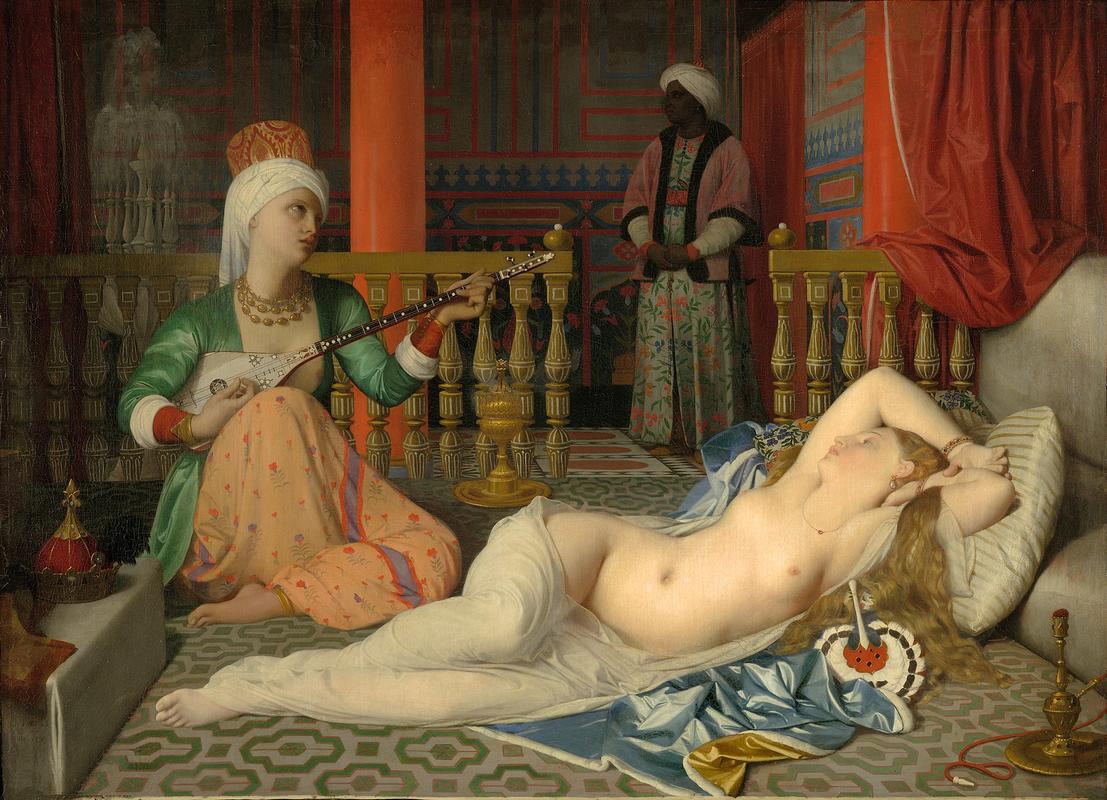More about Odalisque with a Slave

Contributor
Jean Auguste Dominique Ingres’ L'Odalisque à l'esclave, or Odalisque with Slave, was every 19th-century colonizer’s wet dream.
A beautiful naked woman tries to drape her body in rich lavish satin, only it keeps sliding off her body. Not a working class luxury is it? There’s also in-house entertainment. Music and commercial sex have gone hand-in-hand for centuries. A trip to a local strip club will show you that the tradition continues. And before I forget, although Ingres made sure we wouldn’t, there is one standard issue non-white slave in the background.
Ingres wasn’t a slave owner but his patrons and critics surely were. He had a hard time getting the elites of the Paris Salon to take him seriously. They said things like “His Odalisque has three [lumbar] vertebrae too many.” They were wrong. It seems she had an extra five. They also said things like “How, with so much talent, a line so flawless, an attention to detail so thorough, has M. Ingres succeeded in painting a bad picture? ”. Ouch. We feel for you, Monsieur Ingres.
In 1806, after years of rejection from the Salon, Ingres packed his bags and left for Rome. He left everything, including his fiancé, Julie Forrestier. After all of this Julie never got married. She said, “When one has had the honor of being engaged to M. Ingres, one does not marry.” *Cue dramatic eye roll.*
At the French Academy in Rome, Ingres made his first attempt at painting the sinuous reclining woman. In 1809 the King of Naples bought The Sleeping Lady of Naples. The painting subsequently vanished after the fall of Naples in 1815. A few drawings of the odalisque survive. Ingres had not had enough of the sleeping lady. He included her in Jupiter and Antiope (1851) and, of course, the Odalisque with Slave (1839).
It isn’t strange that Ingres included a slave in his painting. At the time they were a sign of opulence. 19th century France was quite the slave trader. Ingres' patrons and critics were sure to have a number. He had spent a lot of time trying to please the French elite and he wasn’t going to stop now. He was working in precarious times, you see. Backers of the Enlightenment movement were already denouncing slavery. England had abolished slavery in 1807. Ingres, however, seemed to care more about his wealthy patrons. Or, maybe, he was trying to slip a little irony past them?
This painting was commissioned by Charles Marcotte, a dear friend of M. Ingres. Charles was a high ranking official in Napoleon’s Government in Rome. Maybe he dreamt the colonial dream as well. I don’t blame him, there were only so many aspirations for a wealthy white man in the 19th century. His imaginary harem had to have a slave, a beautiful naked girl was just not enough.
To be fair, this is more Ingres’ imaginary harem than Charles’. He made his students work overtime, researching and conceptualizing middle eastern motifs like tiles, carpets, and costumes. In fact, he made another version of the odalisque. With a little help from his student, Paul Flandrin, Ingres situated the harem in a garden instead of a room. Oriental harems were quite the rage in the 1800s. Charles’ home became very popular after he displayed this painting in his house in Paris. It even got Ingres some validation from the Salon. The painting now hangs at the Harvard Art Museum in Cambridge.
Monsieur Ingres claimed to be a true bastion of the neoclassical tradition. He was an academic painter. He may have believed he was politically neutral, upholding the values of the Academy and what not. But, he also abhorred romanticism. Eugene Delacroix was his arch-rival. In my eyes, that’s pretty conservative. I mean, who could hate Delacroix? C’mon. Anytime Delacroix would walk in Ingres would say, “I smell brimstone."
Back in 19th century France, roughly ten years after he painted this Odalisque, slavery was abolished. What a blow it must have been for Monsieur Ingres and his rich friends.
Sources
- Maigne, J.-Y., G. Chatellier, and H. Norloff. "Extra Vertebrae in Ingres La Grande Odalisque." Jrsm97, no. 7 (2004): 342-44. doi:10.1258/jrsm.97.7.342.
- Tinterow, Gary. Portraits by Ingres: Image of an Epoch. New York: Harry N. Abrams, 1999. https://archive.org/stream/PortraitsbyIngresImageofanEpoch/PortraitsbyI….
- "La Dormeuse De Naples (painting)." Wikipedia. August 02, 2017. Accessed May 25, 2019. https://en.wikipedia.org/w/index.php?title=La_Dormeuse_de_Naples_(paint….
- "Nantes, the Slave Trade and Slavery." Mémorial De L'abolition De L'esclavage – Nantes. Accessed May 25, 2019. http://memorial.nantes.fr/en/nantes-the-slave-trade-and-slavery/.
- Geggus, David. Enlightenment. Accessed May 25, 2019. http://users.clas.ufl.edu/dgeggus/Enlightenment.html.
- "Odalisque with Slave." Wikipedia. July 12, 2018. Accessed May 25, 2019. https://en.wikipedia.org/w/index.php?title=Odalisque_with_Slave&oldid=8….
- Andrew Graham-Dixon. "ITP 164: Odalisque with Slave by Jean-Auguste-Dominique Ingres | Andrew Graham-Dixon." AndrewGraham. June 08, 2003. Accessed May 25, 2019. https://www.andrewgrahamdixon.com/archive/itp-164-odalisque-with-slave-…
Featured Content
Here is what Wikipedia says about Odalisque with Slave
Odalisque with Slave (French: L'Odalisque à l'esclave) is an 1839 painting by Jean-Auguste-Dominique Ingres commissioned by Charles Marcotte. Executed in oil on canvas, it depicts a nude odalisque, a musician, and a eunuch in a harem interior.
The painting is in the Fogg Art Museum in Cambridge, Massachusetts. It is a classic piece of Orientalism in French painting.
Check out the full Wikipedia article about Odalisque with Slave












